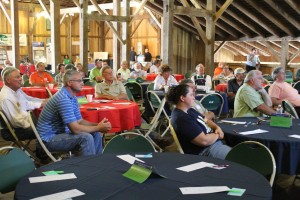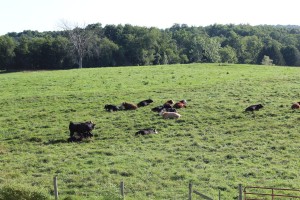(Commentary)
LUCAS, Ohio — At first glance, the type of farming once done at Malabar Farm may seem a bit outdated. After all, it’s been nearly 60 years since the once-famous owner, Louis Bromfield, passed away.
But on the other hand, some of his farming philosophies — like saving soil, reducing runoff and keeping the ground covered during winter — are coming back, in a big way.
Bromfield’s historical farm, now known as Malabar Farm State Park, was the backdrop for a first-of-its-kind gathering July 24, called Technology in Agriculture, Past, Present and Future. The event was organized by the Richland County Farm Bureau, along with Braintree Business Development, and a host of others.
Bromfield, first known for his Pulitzer-prize winning career as an author, later became known for helping to advance conservation practices like contour plowing, crop rotation, no-till and minimum tillage.
Same issues
One of the things that defined the farm when Bromfield purchased it were the many hills and valleys — and the lack of flat ground. Those features are still there today — although thanks to Bromfield’s efforts, the land is much more fertile.
“Everything is a hill and a knob and a valley around here, so we have to be able to keep that soil in place, to make our crop accessible,” said Korre Boyer, today’s farm manager.
Bromfield, in his day, used crop rotation and minimum tillage to correct what had become overworked and depleted soil, suffering from years of poor farming practices.
He shared his ideas with the masses through farm tours, he gave lectures on conservation across the country, and he published dozens of literary works, including award-winning books and newspaper articles.
His fame brought the farm international attention, and by the 1940s, Malabar Farm was regarded as “the most famous farm in America.”
Main point
Today, the farm is a state-owned park. You can go there most days of the year, and visit Bromfield’s restored home and farm buildings.
But what I liked most during the meeting, and what was made very clear, was the emphasis on the future, and what Bromfield’s lessons mean for us today.

“Our goal here at Malabar Farm isn’t to be Louis Bromfield; we’re not here to try to be great innovators,” Boyer said. “Louis Bromfield had that ability in his time … Today, the job here at Malabar Farm is to be educators.”
Having visited his farm many times, and having read several of his books, I must say Bromfield was a wise conservationist, and I believe today’s farmers could still gain from his wisdom.
Point in check: Ohio’s nutrient and water quality issues.
In his book Pleasant Valley, Bromfield was well aware of the water quality and nutrient issues the state would one day face, and he even predicted some of the issues that are now playing out in the western Lake Erie basin.
He writes, “One day the farms of the rich Black Swamp country will have moved into Sandusky Bay, filling it up and leveling off the land of the rich watershed behind it. One day both bay and farm land will be level and the Black Swamp will return.”
Nutrient loss
Now, we certainly have not lost as much soil as to bring back the Black Swamp, but the nutrient loss has been significant.
And how are we controlling the loss today? Through the same use of cover crops, and crop rotation, that Bromfield told us we needed to be doing.
“It is true that in this area (western basin) there are good farmers who practice proper crop rotation and cover their bare cornfields in winter with root blankets of wheat or rye and they are doing a good job of anchoring their soil. Very little of it is going down into Sandusky Bay. But there are others who leave their fields bare to wind and frost and rain.”
Modern era
Later in the day, Ted Lozier, chief of conservation for the Muskingum Watershed Conservancy District, talked about modern-day use of cover crops and the many things the watershed is doing to protect its 54,000 acres.
The Muskingum Watershed is a south-flowing watershed, comprised of about 22 counties, which eventually drain into the Ohio River, via Marietta. The district was created in 1933 and since 1986, has worked closely with the Army Corps of Engineers to reduce flooding and improve conservation.
In recent years, the district has also helped administer, along with ODNR, a state-based cover crop program to help subsidize farmers who grow cover crops.
Farmers can apply for matching funds, and receive about $13 an acre toward the cost of establishing cover crops. This year, about 22,000 acres are enrolled.
As Lozier noted, the district is heavily involved with water quality testing efforts, not only to test potential ag nutrient runoff, but also runoff from acid mine coal drainage, and to establish a basis, to test waters near shale drilling activity.
He said there have been some late-season algal blooms in the Muskingum Watershed, but not at high enough levels to constitute a public warning. A bigger problem, he said, appears to be nitrogen runoff.
“For the most part, the water quality in our reservoirs and the system is good, but we have to continually maintain (that) and do what we can to maintain the watershed,” he said.
Retaining nutrients
The cover crop program is making a difference. He said in the Muskingum Watershed alone, in 2014, sedimentation was reduced by 61,000 tons, saving 53,000 pounds of phosphorus, and 105,000 pounds of nitrogen.
New equipment
In the afternoon, Jay Witkop, John Deere territory specialist, discussed the many ways farm companies are improving the use and placement of nutrients, and how innovations like automated steering and precision planting are helping farmers be more efficient, and more environmentally responsible.
He said Deere can now guide its equipment to within an inch of accuracy in the fields — and he showed how computers have modernized everything from the tractor’s steering wheel, to the planter box.
More technology
The day concluded with a demonstrations on drones, tractors by Shearer Equipment, and tours of Bromfield’s restored home.
The topics were diverse and varied — not easy to write into one article — but certainly gave a good cross-section of some of the things going on in agriculture.

“Technology in agriculture” can mean so many things to begin with — and as we go forward, we will only add new things to the definition.
But as one Farm Bureau member told me as I was leaving, at least with conservation and soil health, “it all comes back to Malabar Farm.”
The lessons learned on that farm helped reshape the industry at a time when it needed reshaping. And I have to wonder, as the state faces some of the runoff and nutrient issues before us today — whether we might be reminded of a few important things in the pages of a place like Malabar.
STAY INFORMED. SIGN UP!
Up-to-date agriculture news in your inbox!














So much to learn from Bromfield and his Malabar experiences! His books introduced me to Ohio agriculture when I moved here from Texas 4 years ago, and continue to inspire me on my own small, sustainable farm.
Great article, thanks for sharing.
Thank you I Harlow.
I love Malabar. They hold a lot of neat events, including the fall harvest festival. His books on conservation are good, but they take a dedicated reader.